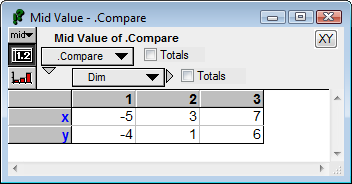VectorCrossProduct
new to Analytica 5.0
VectorCrossProduct( u, v, I )
Computes the vector cross product of two vectors in 3-dimensional space (or in 7-dimensional space). The vectors «u» and «v» are both indexed by index «I», and «I» must have an index length of 3 or 7. The result is also indexed by «I» and has the following properties (up to numeric round-off):
- For a fixed «v», the resulting vector varies linearly with «u».
- For a fixed «u», the resulting vector varies linearly with «v».
- The resulting vector is perpendicular to both «u» and «v».
- The length of the vector is equal to the area of the parallelogram spanned by «u» and «v».
Examples
[x, y]→
VectorCrossProduct(x,y,Dim) →
x1 := Array(J, [1,0,0] )x2 := Array(J, [0,1,0] )VectorCrossProduct(x1, x2, J) → Array( J, [0, 0, 1] )
x3 := Array(J, [3,0,0] )x4 := Array(J, [0,5,0] )VectorCrossProduct(x3, x4, J) → Array( J, [0, 0, 15] )
Why only 3- or 7-dimensional space?
Students of linear algebra learn about the vector cross product in Euclidean 3-space, and many wonder whether the operator generalizes to higher-dimensional spaces. When we assume that the essence of a cross product are the bullet points listed above (bi-linearity, orthogonality, and area equal to the parallelogram), then it turns out that a function with those properties only exists in 3- and 7- dimensional Euclidean spaces. A proof of this is given in Massey (1983).
In practice, when using this, you will probably be working with 3-dimensional space.
See also
- W. S. Massey (Dec. 1983), "[http://www-bcf.usc.edu/~lototsky/MATH226/Handts/CrossProduct-3or7dim.pdf Cross products of vectors in higher dimensional Euclidean spaces," The American Mathematical Monthly, 90(10):697-701
- Sum
- DotProduct -- Note: Usually in Analytica,
Sum(u*v,I)is used for the dot-product. But there is also another function with the name DotProduct.
Enable comment auto-refresher